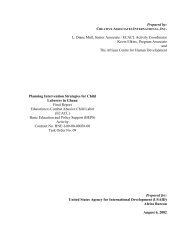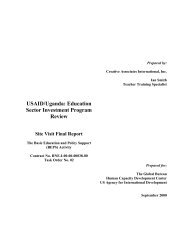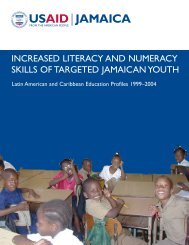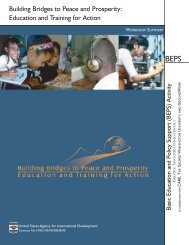Grandmothers: A Learning Institution - Basic Education and Policy ...
Grandmothers: A Learning Institution - Basic Education and Policy ...
Grandmothers: A Learning Institution - Basic Education and Policy ...
- No tags were found...
Create successful ePaper yourself
Turn your PDF publications into a flip-book with our unique Google optimized e-Paper software.
ing to children their connectedness withtheir elders, their ancestors, <strong>and</strong> the earth.He discusses the problems of disconnectedness(with traditional values <strong>and</strong> ceremonies)<strong>and</strong> dysfunction in contemporaryNative American families <strong>and</strong> schools <strong>and</strong>the role of wise gr<strong>and</strong>mothers in promotinginterrelatedness <strong>and</strong> continuity inNative beliefs, values, <strong>and</strong> practices. It islargely through storytelling that gr<strong>and</strong>mothershelp children connect with Nativepeople’s language, values, <strong>and</strong> cultural traditions.In various Native American culturesthe vital teaching role of gr<strong>and</strong>mothers isdepicted in a visual image, reproducedeither on paper or in clay, of a large gr<strong>and</strong>motherwith numerous small children ontop of <strong>and</strong> around her. This image profoundlyreflects the dual teaching <strong>and</strong> nurturingrole of gr<strong>and</strong>mothers in NativeAmerican cultures.Similarly, in Sioux culture gr<strong>and</strong>parents playa vital role “as cultural links to the traditionsof the past <strong>and</strong> as isl<strong>and</strong>s of certaintyin ever-changing society.” Native Americaneducationalist Kincheloe (Kincheloe &Kincheloe 1983) describes the importantrole of gr<strong>and</strong>mothers in child developmentfrom the time of birth, as child-care supportfor busy mothers <strong>and</strong> as educatorson all aspects of life. The authors lamentthe fact that formal schools do not incorporatethe knowledge <strong>and</strong> wisdom of theelder, traditional Sioux educators. “Theschools must not contribute to Americansociety’s tendency to push olderAmericans into the background” (136).She asserts that most formal teachersignore the fact that gr<strong>and</strong>parents constitutea valuable resource <strong>and</strong> ensure the“cultural link” in the development of Siouxchildren. She poignantly argues, “Societyitself fails when it isolates the young <strong>and</strong>the old from one another” (135).AUSTRALIA AND THE PACIFICIn all Aboriginal societies in Australia,respect for the family, tradition, <strong>and</strong> theelders are important precepts. Within thisframework, senior Aboriginal women areexpected to serve as advisors <strong>and</strong> guidesfor young women <strong>and</strong> families (Wilson1999; Koori Elders et al. 1999). As regardsthe health <strong>and</strong> well-being of women <strong>and</strong>children, senior women are expected toshare their expertise <strong>and</strong> pass on to themtraditional ways of promoting health <strong>and</strong>healing.In The Pacific there has been virtually nopublished research on the role of gr<strong>and</strong>mothersin children’s development, accordingto well-known public health doctors,Biuwaimai (1997) <strong>and</strong> Kataouanga (1998),public health nutritionist, Susan Parkinson(2003), <strong>and</strong> community development practitioner,Wanga (2002). On the otherh<strong>and</strong>, all four of these key informants stateunequivocally that in all Pacific isl<strong>and</strong> cultures,older women have played in thepast, <strong>and</strong> continue to play, a significant roleat the household level in all matters relatedto child health <strong>and</strong> development.Parkinson states that in both rural, <strong>and</strong> socalled“urban contexts,” senior women playan important role in childcare, <strong>and</strong> particularlywith infants (2003). She states that inboth major ethnic groups in Fiji, theIndigenous Fijians, <strong>and</strong> Indo-Fijians, bothgrannies <strong>and</strong> aunties in the family areimportant household advisors <strong>and</strong> teachGRANDMOTHERS:THE LEARNING INSTITUTION13







